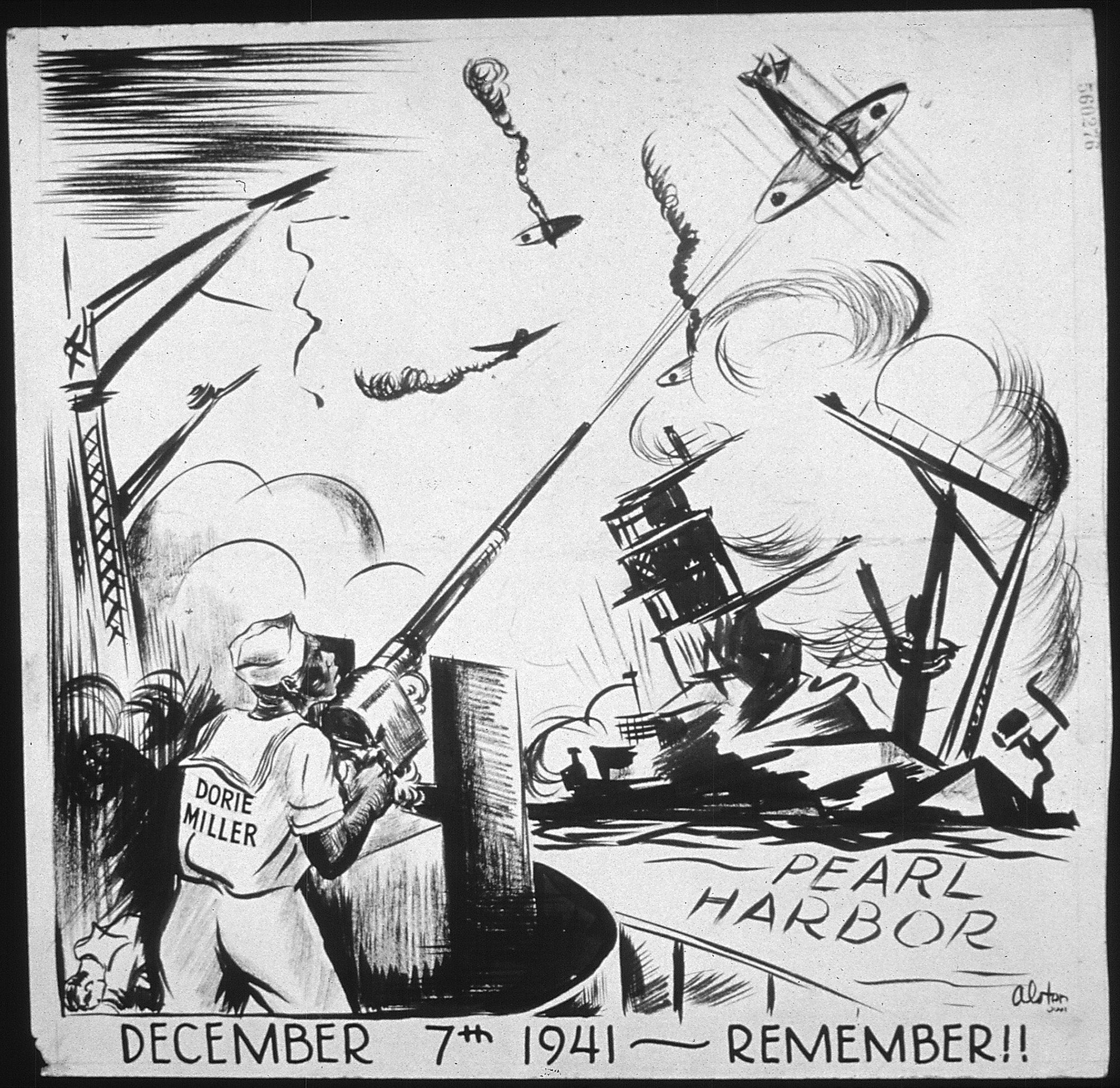Doris “Dorie” Miller was serving as a cook aboard the battleship West Virginia when the Japanese attacked Pearl Harbor on December 7, 1941. Although not trained on it—Black naval recruits were typically confined to the Stewards Branch, cooking and serving food—he manned an anti-aircraft gun. Officially credited with downing two Japanese planes, he helped rescue fellow wounded sailors after running out of ammunition. Miller became the first Black sailor to be honored with the Navy Cross—but only after political pressure applied by the NAACP, the African American press, and leftists.
“The ways in which Doris Miller was represented between 1941 and the present reveal the development of a memorial paradigm through which the wartime and postwar history of the US racial hierarchy was (and is) simultaneously addressed and eclipsed,” writes American Studies scholar Robert K. Chester.
Miller’s memorial afterlife represents what Chester calls “retroactive multiculturalism.” Long after the sailor died in combat in 1943, he was re-enlisted in the “identifying of the armed forces with ideological color blindness and attributing to World War II and nonwhite service therein the death of racism in military culture (even in the nation as a whole).”
It actually took a few months before anybody outside the Navy even knew the identity of the “unnamed Negro messman.” Secretary of the Navy Frank Knox, who adamantly opposed Black men in combat roles, was reluctant to recognize Miller as one of the first heroes of the war.
The Pittsburgh Courier, one of the nation’s major Black newspapers, ferreted out Miller’s identity in March 1942. Miller quickly became known as a symbol of the Double V civil rights campaign: victory against fascism abroad and victory against Jim Crow at home. There were demands for an appropriate honor for Miller. While the white Congressman representing Miller’s own Texas hometown doubled-down for complete segregation in the military, a Michigan Congressman and a New York Senator (both white) recommended Miller for the Medal of Honor.

The Navy opposed a Medal of Honor but granted Miller the Navy Cross in late May 1942. But unlike the white sailor who also received the Navy Cross for his actions on December 7, Miller wasn’t promoted or sent back to the US on a morale-boosting speaking tour. Additional political pressure and protest were launched on his behalf, and he eventually toured the States in December 1942. In June 1943, he was promoted to cook third class. He died in November 1943, when the escort carrier Liscome Bay was torpedoed, one of the 644 men who went down with the ship.
After the war, Miller was mostly forgotten. He was sometimes referenced when people noted how far the military had progressed in integration, which was largely complete, at least in theory, by the mid 1950s. An ironic early post-war honor was San Antonio’s naming of a segregated elementary school after him in 1952 (the state’s segregationists battled school desegregation for a decade after Brown vs. Board of Education).
Yet by the early 1970s, there were a host of social pressures that brought remembrance of Miller fully out of mothballs. In 1973, in the midst of reforming what the Navy’s own (white) chief of operations called a “lily-white racist” institution, the Navy commissioned a frigate named the USS Doris Miller.
Miller was even the inspiration of one of Ronald Reagan’s bizarre race anecdotes, the gist of which was that the “great segregation in the military forces” was “corrected” in World War II. Reagan described a “Negro sailor…cradling a machine gun in his arms.”
“I remember the scene,” said the future president in 1975, possibly referring to the few seconds footage of a Miller-like figure in Tora! Tora! Tora!, a Japanese-US co-production about Pearl Harbor in 1970.
Weekly Newsletter
The character of Miller wouldn’t have a speaking role in a war movie until 2001’s Pearl Harbor. In a good illustration of Chester’s thesis about retrospective or retroactive multiculturalism, the white characters around Miller in the movie didn’t seem to harbor any prejudice.
In 2010, Miller was honored as one of four Distinguished Sailors on a US postage stamp. Three years ago, a nuclear-powered aircraft carrier—not scheduled for commissioning until 2032—was named after him, the first time an enlisted man has received such an honor.
Support JSTOR Daily! Join our new membership program on Patreon today.







